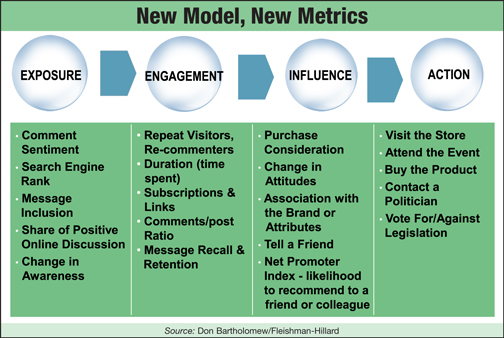If you peruse the numerous PR-related blogs in cyberspace, there’s constant chatter involving one theme: measurement and the ability to prove business value and ROI.
From the sound of it, PR is transforming so fast that tried-and-true techniques and metrics no longer apply. Do PR pros have to reinvent the wheel before the hammer of accountability comes down from above?
Don Bartholomew, VP of digital research at Fleishman-Hillard and author of the MetricsMan blog (metricsman.wordpress.com) is one person that preaches change for PR measurement—and big changes at that.
“PR measurement is at a crossroads, and the old techniques are no longer sufficient,” says Bartholomew. “Old metrics are no longer applicable, and old thinking must be replaced by new.”
Why the change? There’s a transformation occurring that affects more than just PR, says Bartholomew. The lines are blurring between advertising and digital agencies, which may be integrated with PR firms. “I see quite a few PR campaigns that run banner adds—is that PR or advertising?” he asks. When you add social media into the mix, “PR has to think much more broadly about what it measures, and how it measures,” Bartholomew says.

OUT WITH THE OLD
To think more broadly, PR practitioners have to leave some traditional thoughts and processes behind. They include:
â–¶ Media relations focus: Bartholomew believes that as traditional media declines, the focus on media relations as we know it should also decline. That belief is shared by Katie Paine, CEO of PR and measurement agency KDPaine & Partners. But, says Paine, traditional media relations practices are so ingrained in the minds of CMOs (many of whom oversee the PR function) and CEOs that it’s a hard road to climb for PR pros looking to change. (Look for articles on the marketing/PR connection in upcoming issues of PR News —Ed.)
â–¶ Outputs vs. outcomes: The need for accountability and contribution to the bottom line has never been more essential, says Bartholomew. That’s why output metrics such as impressions or message delivery should be discarded. “We need to focus instead on outcomes that show what happens as a result of the campaign or coverage,” he says. “It all comes down to what is PR doing to drive the business.”
Two examples of endangered outputs are the AVE (ad value equivalency) metric, and impressions. PR has used AVEs for years to correlate earned media value with other PR efforts. “AVEs are not outcome focused, only apply to traditional media and are interpreted differently by every organization in every case,” says Bartholomew. In fact, says Paine, the Institute for Public Relations recently voted down the use of AVEs, but the practice continues.
Impressions have also seen better days, says Paine, who gives a personal glimpse into their value, but in Internet terms. “I have a presentation up on Slideshare, and the metrics say I have 10,000 views of it,” she says. “A total of 41 made it back to my Web site. What good is that 10,000?”
â–¶ Return on investment vs. engagement. “There’s much confusion between creating value and ROI,” says Bartholomew, adding that generating awareness creates value, but may not immediate result in demonstrable ROI. What’s more, while ROI appears to be the metric for marketers, Bartholomew feels that not many marketers are able to prove ROI.
NEW IDEAS
Bartholomew and his team at Fleishman have come up with some alternatives to current PR measurement thinking, which include:
â–¶ Total value of PR. Think about the total value of all PR efforts, including traditional methods and social media. “Current measurement is focused on marketing, exposure and revenue generation,” he says. “We need to look at brand reputation, engagement, influence, action and cost savings and cost avoidance.”
Paine has another important consideration: the need to look at competitors. “I want to know their share of interest, share of engagement and the ratio between total number of posts and total number of comments,” she says.
â–¶ New model for measurement. Bartholomew’s model (see graphic) includes four components:
• Exposure: To what degree have we created exposure to content and message?
• Engagement: Who, how and where are people interacting/engaging with our content?
• Influence: The degree to which exposure and engagement have influenced perceptions and attitudes.
• Action: As a result of the PR/social media effort, what actions, if any, has the target taken?”
Bartholomew says that implementing this type of model and metrics will require a much broader view of PR and an emphasis on a variety of nontraditional tools, including Web analytics, media content analytics and click-tracking technologies—with primary research integrated into the process.
“We can understand the what’s, the where’s and the who’s with Web analytics and digital tools, but the PR pro still has to ask questions,” says Bartholomew. PRN
CONTACT:
Don Bartholomew, [email protected]; Katie Paine, [email protected].
